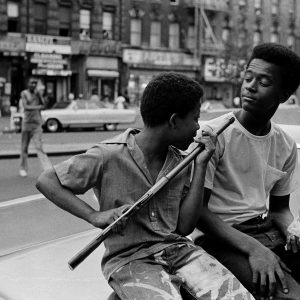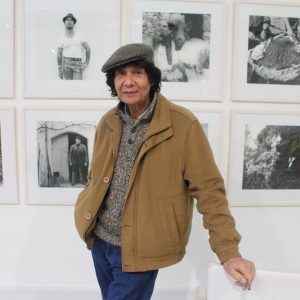Biddy Partridge’s photographic archive of exile
The photographer and musician’s negatives reveal moments of artistic exile in Harare. Years later, she is tracking down the people in these images and their kin, exploring the memories they trigger…
Author:
28 September 2020

Meeting Biddy Partridge in October 2015, over an English breakfast with her niece Sarraounia Samuels, was an encounter with more than just eggs and baked beans. Born Bridget June Partridge in Kenya in 1950 and raised in South Africa, she also dished up stories about her stacks of black-and-white negatives from the two decades in which she worked as a photographer in South Africa and Zimbabwe.
“In my filing cabinet I have several hundred contact sheets, taken between 1979 and 1999, developed and printed in my darkrooms in Joburg and then Harare. They hold a thread of history and fragments of many lives,” says Partridge today of her visual archive, which has not been widely exposed. The predominant narrative is that of life for some South Africans in exile.
Partridge became entrenched in this community when she met South African Nigel Samuels in Joburg. By 1980, they had left the country to get married in newly independent Zimbabwe as interracial marriage wasn’t permitted under apartheid. There, they worked as musicians. Other Samuels family members moved to Britain, where Sarrounia’s family still lives.
Related article:
“I started documenting exile life in Harare … It came naturally to me to photograph my surroundings and the people and events in it,” says Partridge. “My archive holds images of over 100 different musicians, visual artists, poets, writers and actors in Durban, Johannesburg and Harare.
“I think it’s time to show these images. Many of them are unpublished. They tell my story and the stories of a great many others.”
More than just a collection of stories, Partridge’s archive is also an example of how South Africa’s apartheid government silenced voices, fragmented families and claimed lives but could not erase all the evidence of its past, which is still being uncovered. This visual evidence of the lives of “many others” is not the only archive that depicts South Africans in exile. But like other photographers’ work, it is another reflection on how apartheid affected and dispersed South Africans, another piece of history.
It also reveals how exiled families have stayed connected, South Africans who chose exile over the stranglehold of apartheid – neither offering an easier life.
Exploring the archive
Partridge’s archive perhaps fills a gap in South Africa’s collective memory, from a time about which many might still have questions. In the years since moving home, Partridge has also spent time in London where she “slowly scanned, dated and captioned” a lot of the negatives, reflecting on that time and those who were in exile while doing so.
“I have exhibited some and published some, and thought a lot about their meaning, value and usefulness in this digital age,” she says. “I have started the huge and fascinating process of finding out who is alive, are they still active in art and how best to connect [with them]. I’ve discovered that a surprisingly large number of their children are hugely successful artists.”
Among these are poet Mak Manaka, whose mother Nomsa Kupi Manaka was an award-winning dancer and choreographer; Turiya Magadlela, who is an artist and the daughter of visual artist Fikile Magadlela; and Kemang Wa Lehulere, who is the son of musician David McKibben and singer Letsego Lehulere.
There’s also contemporary multidisciplinary artist Breeze Yoko, with whom Partridge has recorded video interviews. These conversations discuss the connection between the late musician Winston Ngozi Mankunku’s song Yakhal’inkomo and the paintings Yoko made, inspired by the song.

“I want to document what memories are triggered by my photographs, and what meanings it has for the future. I have realised the power these images have to connect younger generations with the past. This, for me, is where the power lies, showing connections that may have previously been invisible,” says Partridge in the recorded interviews.
Her video documentary process entails asking the interviewee “what connections arise” while viewing her photographs of their parents, relatives or other people they know. “Do you have thoughts about the image which are uncomfortable – relating to yourself, your history, your family, or relating to the photographer and her lens or viewpoint?” she asks the viewer.
Related article:
Focusing the camera on a more personal space, Partridge wants to interview her two sons “about their memories and emotions as they look at images of themselves growing up among astonishing musicians and considerable freedom in Zimbabwe.
“What do they remember about the many South African visitors and the music that was around them?
“I want to record my conversation with my eldest son Karim about his tour as a trumpeter with Thomas Mapfumo and the Blacks Unlimited. And my younger son Richard, now a sound engineer, about his memories of days spent at the studio while we recorded and mixed our music.”
Another artist Partridge wants to interview is writer and actress Gcina Mhlophe, whom she photographed in 1979. Mhlophe has gone on to perform on stages worldwide and appeared in multiple television shows.

Rewriting from a new perspective
This work of revisiting and recording memories is about retracing history and rewriting it, too, from the perspective of the oppressed. It echoes the work of Cape Town academic Siona O’Connell, whose exhibitions and publications have been digging into archives to broaden narratives. Curating an archive with the intention to refocus the narrative from the perspective of the oppressed offers a different, more inclusive understanding of South Africa’s past.
Meanwhile, Karim has helped his mother curate an exhibition of photographs from the time she worked with Staffrider, a magazine launched in 1979 to “provide publishing opportunities for community-based organisations and young writers, graphic artists and photographers, and to oppose officially sanctioned state and establishment culture”.
Staffrider, which stopped publishing in 1993 as South Africa transitioned to democracy, borrowed its name from township slang for “black youth who rode the overcrowded African sections of the racially segregated commuter trains by hanging on to the outside or sitting on the roofs”. It aimed to be a witness to black life in South Africa under apartheid. Partridge’s work was published in this magazine and one of her curatorial projects has been to showcase these photographs as a chapter of her archive through small presentations at cultural institutions.
Partridge has also presented these photographs in academic spaces, including at the University College of London, the University of Basel and the University of Cape Town, in recent years.
‘Small legacy’
In late October, British publisher Routledge will publish Women and Photography in Africa: Creative Practices and Feminist Challenges. Partridge has a research paper in the book.
“As soon as the images were released from their negatives, stories started pouring forth. My hope is that this small legacy, my work, will inform and interact with the new generation shaping and writing history with their own voices,” says Partridge.
“I know only a tiny percentage of what the people in my photographs experienced during apartheid. These images capture only flashes of that.” As part of the archive of life under aparthied, Partridges says her “focus was always on the resilience, creativity, beauty, humour, courage and dignity I saw. And on the collective spirit.”
Years after that initial breakfast, Partridge had a stroke that has impaired her speech. She continues to curate and sort her archive, seeking spaces to share it with an audience. Her short film interviews with the children of South African exiles still need to be edited into a series.
“My interest is in the collaborative possibilities around some of my images, a collectivisation of heritage perhaps,” she says.
“As we consider this fragment of history together, where does it lead us? Does it take us to a moment of hope? Or a moment of fury and nihilism?
“Does it lead to a ‘something to be done’? Or to a paralysis that negates our historical efforts as misguided or meaningless? Might it lead to a deepening of relationship or into further distance?”






